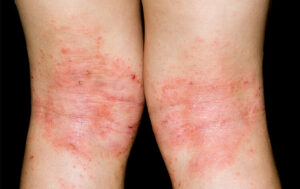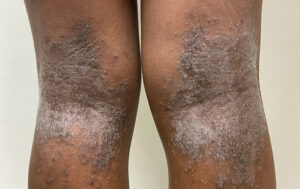Managing atopic eczema in the community: A practical guide for pharmacists
Community pharmacist and dermatology specialist Sunil Kochhar provides an overview of atopic eczema management, including key pointers on differential diagnosis, appropriate treatment and referral and how to support patients with effective self-management
Atopic eczema, also known as atopic dermatitis, is a chronic, inflammatory skin condition that often begins in childhood but can persist or recur into adulthood. While eczema and dermatitis are synonymous terms describing skin inflammation, ‘atopic eczema’ refers to the most common subtype associated with atopy, the genetic tendency to develop allergic conditions such as asthma and hay fever. Other forms of eczema exist, but this article focuses on atopic eczema.
In the UK, atopic eczema is frequently encountered in community pharmacy practice. Its prevalence, coupled with the significant burden on quality of life, makes early recognition, evidence-based management and patient support essential. Pharmacists are often the first healthcare professionals consulted, placing them in a pivotal position for timely intervention.
Pathophysiology and presentation
The exact cause of atopic eczema is unknown, but possible contributory factors include a genetic predisposition, skin barrier dysfunction, and immune dysregulation. Environmental triggers, such as allergens, irritants, climate changes and stress, often exacerbate symptoms.
Pruritus (itching) is the hallmark feature, driving the itch–scratch cycle that further disrupts the skin barrier. Acute lesions may appear erythematous, dry and inflamed, and can progress to weeping or crusting (see image 1). Chronic scratching may lead to lichenification - thickened, leathery skin (image 2).
In infants, atopic eczema commonly affects the face and scalp; in older children and adults, flexural areas such as the elbows, knees and wrists are typical. Other sites may include the hands, neck, and upper chest.

DR P. MARAZZI / SPL
Image 1. Rash due to atopic eczema on back of knees in a 3 year old male.

RICHARD USATINE MD / SPL
Image 2. Atopic eczema with lichenification on legs of a 17 year old female.
Related Article: Government partners with TikTok on overseas cosmetic surgery campaign
Diagnosis
NICE guidance recommends diagnosis based on clinical history, family history and characteristic signs, such as persistent pruritus with dry skin and inflammation in typical distribution patterns.
Differential diagnosis should consider:
- Psoriasis: well-demarcated, silvery plaques, contrasting with diffuse redness typically seen with eczema; psoriasis is also less common in children than eczema.
- Contact dermatitis: more localised reaction to an allergen or irritant.
- Fungal infections: such as tinea corporis, presenting with ring-shaped lesions with a clear centre.
Management approach
Both NICE and the British Association of Dermatologists (BAD) advocate a stepwise approach:
- Daily skincare with emollients.
- Topical anti-inflammatories during flares.
- Adjunctive therapies for itch control.
- Systemic or biologic agents for severe, refractory cases.
Emollients
Emollients are the cornerstone of eczema management. These are moisturisers that help restore the skin’s natural barrier and prevent moisture loss, which is a major factor in eczema. Emollients should be used liberally and frequently throughout the day, especially after bathing, when the skin is still damp. NICE recommends that patients with eczema should apply emollients at least twice daily to maintain skin hydration and prevent flare-ups.
There are various types of emollients available, including creams, ointments and lotions.
Ointments are generally more effective for severe dryness but may be greasy and less cosmetically acceptable. Creams are lighter and more suitable for daytime use. Patients should be advised on the correct application techniques, ensuring that they apply emollients generously to the affected areas, in the direction of hair growth and avoid rubbing the skin, which can exacerbate irritation.
Topical corticosteroids
Topical corticosteroids are the most widely used treatment for controlling inflammation during eczema flare-ups. The British National Formulary (BNF) outlines the different types of corticosteroids, ranging from mild to potent, which are used depending on the severity and location of the eczema. For instance, a mild corticosteroid such as hydrocortisone is often used for facial eczema, while more potent corticosteroids, like betamethasone or clobetasol, may be required for more extensive or stubborn eczema, especially on thicker skin areas like the palms or soles.
However, it is crucial to educate patients on the appropriate use of corticosteroids to avoid potential side effects such as skin thinning or stretch marks. NICE guidelines recommend using the lowest potency corticosteroid that effectively controls the condition and for the shortest duration necessary. Patients should be advised to apply corticosteroids in a thin layer and to follow prescribed treatment regimens carefully.
Topical calcineurin inhibitors
Topical calcineurin inhibitors like tacrolimus or pimecrolimus can be used as an alternative to corticosteroids, especially on body sites where the use of corticosteroids carries higher risk, such as the face or genital areas. These drugs work by suppressing the immune response and reducing inflammation without the risk of skin thinning associated with corticosteroids. The BNF notes that topical calcineurin inhibitors should be reserved for patients who do not respond to conventional treatments or for those with frequent flare-ups in sensitive areas.
Antihistamines
Oral antihistamines may be used to alleviate itching, particularly in severe cases. However, NICE advises that antihistamines should only be used for short-term relief during flare-ups, as they do not address the underlying inflammation. Sedating antihistamines, such as hydroxyzine, may be helpful at night to reduce sleep disturbances caused by itching, but non-sedating antihistamines should be considered for daytime use to avoid drowsiness.
Systemic treatments
Related Article: Dermatology quick quiz: Common eczema presentations
In cases of moderate-to-severe eczema that do not respond to topical treatments, systemic therapies may be required. NICE guidelines recommend oral corticosteroids for short-term flare-up management, but long-term use is not advised due to potential side effects. Other systemic treatments, such as cyclosporine or methotrexate, may be considered for severe cases that are resistant to topical treatments. Biologic therapies, including dupilumab, have also emerged as promising treatments for severe eczema and are included in the NICE guidelines for patients who have not responded to other treatments.
Supporting patients with self-management
Pharmacists have a unique opportunity to provide continuity of care through frequent contact with patients and families. This allows insight into lifestyle factors, product use and adherence patterns that may be contributing to persistent symptoms.
Importantly, atopic eczema often causes considerable parental anxiety, especially around topical corticosteroid use (‘steroid phobia’). Pharmacists can offer trusted, evidence-based reassurance, reinforce correct application techniques and address concerns, thereby improving adherence and outcomes.
Pharmacists often see patients in their everyday contexts, at the pharmacy counter, in the aisles selecting skincare products, or during casual conversations. These interactions give pharmacists a broader view of the patient’s lifestyle, which can influence eczema flare-ups. For example, patients may reveal that they are using soaps or detergents that trigger their symptoms, or that they have been under significant stress, which is a common exacerbating factor for eczema. In contrast, patients often have less frequent, more formal consultations with their GPs, meaning the pharmacist is better positioned to offer continuous care and support.
By engaging in these regular conversations, pharmacists can identify clues that may explain why eczema isn’t responding to treatment, such as non-adherence to prescribed therapies or environmental factors that are aggravating the condition. Moreover, patients are often more comfortable discussing aspects of their lives, such as dietary habits or daily routines, which can help in identifying triggers that might not be obvious to other healthcare professionals.
Practical contributions include:
- Identifying and counselling on trigger avoidance (eg, fragranced soaps, harsh detergents).
- Demonstrating emollient application.
- Advising on step-up/step-down topical therapy.
- Encouraging prompt review for signs of infection or poor control.
Red flags requiring referral
Pharmacists should refer promptly if any of the following are present:
- Severe, generalised or treatment-resistant eczema.
- Signs of secondary bacterial infection: increased erythema, pus, yellow crusting, warmth or fever.
- Possible eczema herpeticum: rapidly worsening rash with painful, clustered vesicles and systemic symptoms. This is a dermatological emergency.
- Facial or genital involvement needing specialist care.
- Systemic illness: weight loss, lymphadenopathy or unexplained fever.
Patient education and safety netting
Patient education is vital for the effective management of eczema. Pharmacists should advise patients to apply emollients regularly, avoid known triggers and follow their prescribed treatments closely. Patients should be informed that eczema is a chronic condition, and although flare-ups may occur, consistent use of emollients and topical treatments can help control symptoms and prevent future exacerbations.
Pharmacists should also educate patients on the potential for secondary bacterial infections. They should advise seeking medical help if signs of infection, such as increased redness, yellow crusting, pus, or fever, develop. It is essential to remind patients to complete the full course of prescribed treatments to prevent recurrence and reduce the risk of complications.
Sunil Kochhar is a community pharmacist and pharmacy advisor to the British College of Dermatology
Related Article: Pharmacy First: Top tips for managing non-bullous impetigo
About the British College of Dermatology
The British College of Dermatology, the educational arm of the British Association of Dermatologists, has developed education modules to support pharmacists managing skin conditions, such as acne vulgaris, psoriasis, atopic eczema, infections, and promoting sun safety. Learn more here
Sources and further information
- Atopic eczema in under 12s: diagnosis and management. [CG57] 2007; last updated 2023
- Patient leaflet – Atopic eczema. Available at: https://www.bad.org.uk/pils/atopic-eczema
- Treatment summaries – Topical corticosteroids. Available at: https://bnf.nice.org.uk/treatment-summaries/topical-corticosteroids/
- Treatment summaries – Eczema. Available at: https://bnf.nice.org.uk/treatment-summaries/eczema/#related-treatment-summaries

Have your say
Please add your comment in the box below. You can include links, but HTML is not permitted. Please note that comments are not moderated before publication and the views expressed are those of the user and do not reflect the views of The Pharmacist. Remember that submission of comments is governed by our Terms and Conditions. You can also read our full guidelines on article comments here – but please be aware that you are legally liable for any libellous or offensive comments that you make. If you have a complaint about a comment or are concerned that a comment breaches our terms and conditions, please use the ‘Report this comment’ function to alert our web team.